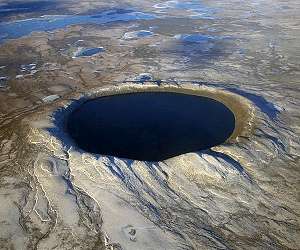Cornell astronomers believe bright reflections beneath the surface of Mars’ South Pole are not necessarily evidence of liquid water, but instead geological layers.
“On Earth, reflections that bright are often an indication of liquid water, even buried lakes like Lake Vostok,” said Dan Lalich, research associate. “But on Mars, the prevailing opinion was that it should be too cold for similar lakes to form.”
But the fact remains, Lalich said, that the bright reflection exists and requires an explanation.
Lalich created simulations with layers composed of four materials – atmosphere, water ice, carbon dioxide (CO2) ice and basalt – and assigned each layer a corresponding permittivity, an intrinsic property of the material describing its interaction with electromagnetic radiation passing through it.
Simulations using three layers – two CO2 layers, separated by a layer of dusty ice – produced reflections as bright as the actual observations.
“I used CO2 layers embedded within the water ice because we know it already exists in large quantities near the surface of the ice cap,” Lalich said. “In principle, though, I could have used rock layers or even particularly dusty water ice and I would have gotten similar results. The point of this paper is really that the composition of the basal layers is less important than the layer thicknesses and separations.”
From the models, the researchers determined that the thickness of the layers and how far apart they are have a bigger impact on reflection power than the composition of the layers. While no single simplified stratigraphy in the paper can explain every observation, the researchers wrote, “we have shown that it is possible to create bright reflections without liquid water.”
It’s important to figure out what’s not liquid water on Mars, Lalich said, because the stakes are so high. “If there is liquid water,” he said, “maybe there’s life, or maybe we could use it for future human missions to Mars.”
Liquid water could also have important implications for the age of the polar cap, the internal heating of Mars, and how the planet’s climate has evolved in the geologically recent past – and Lalich does not rule it out entirely.
“None of the work we’ve done disproves the possible existence of liquid water down there,” Lalich said. “We just think the interference hypothesis is more consistent with other observations. I’m not sure anything short of a drill could prove either side of this debate definitively right or wrong.”
Research Report:Explaining Bright Radar Reflections Below The South Pole of Mars Without Liquid Water
Related Links
Cornell University
Mars News and Information at MarsDaily.com
Lunar Dreams and more
|
We need your help. The SpaceDaily news network continues to grow but revenues have never been harder to maintain. With the rise of Ad Blockers, and Facebook – our traditional revenue sources via quality network advertising continues to decline. And unlike so many other news sites, we don’t have a paywall – with those annoying usernames and passwords. Our news coverage takes time and effort to publish 365 days a year. If you find our news sites informative and useful then please consider becoming a regular supporter or for now make a one off contribution. |
||
|
SpaceDaily Contributor $5 Billed Once credit card or paypal |
SpaceDaily Monthly Supporter $5 Billed Monthly paypal only |
|

![]()
Number of ancient Martian lakes might be dramatically underestimated
Hong Kong, China (SPX) Sep 21, 2022
Lakes are bodies of water fed by rainfall, snowmelt, rivers and groundwater, through which, Earth is teeming with life. Lakes also contain critical geologic records of past climates. Though Mars is a frozen desert today, scientists have shown that Mars contains evidence of ancient lakes that existed billions of years ago, which could contain evidence for ancient life and climate conditions on the red planet.
Through a meta-analysis of years of satellite data that shows evidence for lakes on Mars, … read more